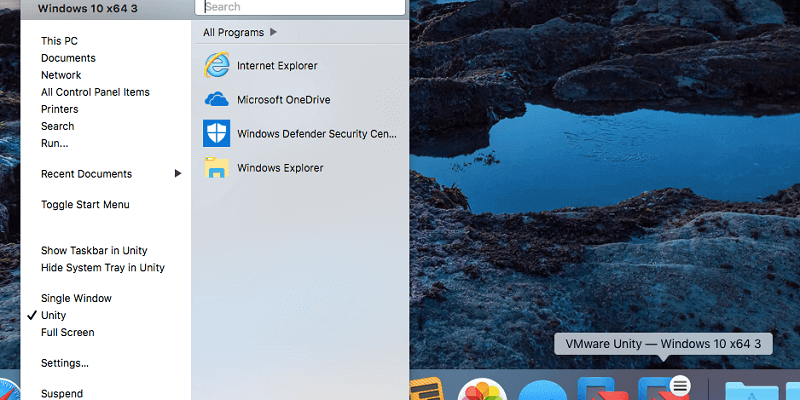

- #VMWARE FUSION MAC NO MOUSE HOW TO#
- #VMWARE FUSION MAC NO MOUSE MAC OS X#
- #VMWARE FUSION MAC NO MOUSE WINDOWS 8#
- #VMWARE FUSION MAC NO MOUSE WINDOWS#
The “Charms” bar, for instance, gets you into things like Windows Settings, so, you know, kind of a big deal. That’s because they’re hidden behind gestures that don’t quite work when your Windows machine is really a window on a Mac.
#VMWARE FUSION MAC NO MOUSE WINDOWS 8#
It was designed with touchscreens in mind as in, “Everyone has touchscreens now!” This was a) obviously wrong, and b) not even true for most brand-new computers shipping with Windows 8 pre-installed.įor the unfortunate souls suffering with Windows 8 or 8.1 under VMware Fusion, some functions are almost impossible to access. Using Windows gesturesĬhances are, even a die-hard Microsoft fan’s operating system of choice isn’t Windows 8. If they really want to shut down the virtual machine, they can do that from the Start menu. It says, “You can suspend it for later use or power it off now,” but also offers “Cancel” and “Run in Background” options. You can give your users the confirm dialog box if you want, but it’s needlessly confusing. Under General, select Suspend the virtual machine Learning that fact is useful not only in regard to Fusion, but any other application.įor it to be idiot-proof in Fusion, you’ll just need to tick a few boxes so that quitting the program gracefully suspends the Windows virtual machine. These two functionally identical commands totally quit the active Mac program, flushing it from memory. Offering users several options might seem like a good idea, but it’s really only necessary to give them two: > Quit and Command+Q.
#VMWARE FUSION MAC NO MOUSE HOW TO#
So you can upgrade that computer’s hardware, requisition an altogether new machine, or teach the user how to really actually totally quit Fusion. It also has a nasty habit of leaving behind giant files if the Mac gets restarted while Fusion is still running. And Fusion doesn’t like to give up resources it will keep running in the background and bog down everything else. Not that that’s a problem, since your user won’t have any other applications open at the same time, right?

Plus, whatever virtual machine you run will cordon off memory and processor cores all for itself, making them unavailable for other tasks. Version 8 requires 4GB of RAM at a minimum, and we all know the system requirement for RAM is always a bare, bare minimum. Only, no, that doesn’t quit the whole program, it only closes that window.įusion is great, but it is not gentle on computer resources. Leaving VMwareFusion runningĮven experienced Mac users will make this mistake: click the red X to close a program. It’s best to take the button away altogether, by right-clicking that gray area, selecting Customize Toolbar… and dragging the button off.īeyond the confusion, you don’t want anyone forgetting that Fusion is running at all. Plus, if you hit that button when no Windows programs are running, the VM disappears and you have to click View > Single Window to get it back. That’s fine if you really want to switch between all your programs seamlessly, but in many cases, you want to remind your users that they’re in their Windows environment.

That button enters Fusion’s Unity mode, which strips away the Windows desktop and only shows the Windows applications that are running. VMware, however, can be blamed for the “Unity” button. So updating the operating system again caused an unexpected full-screen incident.
#VMWARE FUSION MAC NO MOUSE MAC OS X#
In later Mac OS X versions, that function was moved to the green button in the upper left, and to make it do what it used to do (zoom, or enlarge the window to fit the content), one had to hold the Option key as well. Not accustomed to Macs, she panicked, of course. She’d pressed that button and the Windows virtual machine had taken over her whole screen. When I tweeted that last summer, my user was still on Mac OS X 10.8, which still had a dedicated full-screen button in the upper right corner of most windows.


 0 kommentar(er)
0 kommentar(er)
